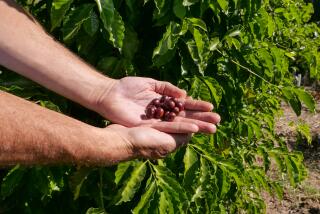The Coffee Revolution : A Top Gun in the Coffee Trade : Jet Palate: How an ex-aviator found a new kind of fast track.
- Share via
W. C. (Dub) Hay used to be a Navy jet pilot--he still has the appropriate forceful and clean-cut look. These days, though, he goes into a San Francisco office every morning and starts tasting coffee. He’s the vice president of commodities for Nestle-Hills Bros. and one of the most important coffee buyers in the world.
The transition from jets to java was simple, as he sees it: “When I left the Navy, I was bored with the working world.” Then he encountered some coffee traders back from Africa, saw how worked up they were about their purchasing triumphs and the whole subject of coffee and immediately quit his job buying diaper materials for Pampers.
Coffee proved to be his destiny. He worked for Folgers for 10 years, and for the last 10 he has been with Hills Bros. These days he buys 435 million pounds of coffee a year, and although Hills Bros. makes the sort of mass-produced coffee that specialty roasters look down on, people in the coffee specialty trade respect his coffee-tasting--and buying--skills.
His day starts at 5:30 a.m. because of the need to stay on top of what’s going on at the Coffee, Sugar and Cocoa Exchange in New York. For a huge operation such as Hills Bros., the all-important thing is to keep a steady supply of blendable beans moving at just the right speed to Hills’ seven roasting plants around the country. Besides buying in the coffee commodity market for near-term use, Hay has to hedge in coffee futures to reduce price swings.
The beans he buys are a blend of arabicas and robustas, which to a coffee connoisseur is like saying a blend of steak and leather. “Tastes have changed in the last five years,” he admits. “The public has become more discerning, and our blends have improved--I bet we’re paying 20% more into the product.
“We applaud this. It’s a pull-through from the public. The 25-year decline in coffee consumption has bottomed out, and I think the better quality of coffee is the reason for the reversal.”
In particular, Hay sees a resurgence of coffee-drinking among younger people. “We missed the ‘60s generation of coffee drinkers. They were rebelling, they drank soft drinks in the morning instead of coffee. Coke in the Morning and Pepsi AM were soft drinks directed against the coffee industry, but they flopped. Now there are coffee carts on certain (college) campuses, they can make you fresh espresso or cappuccino or anything.”
Hills has been trying to catch the premium coffee wave. It recommends making coffee by the drip method or in a plunger pot, rather than a percolator. It has bought a small roaster named Sark’s and sells a line of Sark’s Supreme whole beans in supermarkets: Kenya AA, Guatemala Antigua, Costa Rica Terrazu and so on.
Sark’s is also roasted darker than canned Hills Bros. Hay insists that most people like a lighter roast (“you lose a lot of flavor intensity in dark roasts, all you taste is the roast”), especially on the West Coast, where Hills sells a lighter roast than it does in the East. “Out here,” he says, “we drink our coffee black. In Boston, 80% of all coffee is drunk with milk and sugar, and they need a darker roast.”
Coffee connoisseurs tend to think the pressure went the other way--on the West Coast, large-scale roasters dominated the coffee market sufficiently to impose a light roast as the standard. The attraction of a light roast to a merchant is obvious: Coffee beans lose 18% of their weight when roasted dark, but only 14% when roasted light. But the fact that Hills Bros. is now catering to the taste for darker roasts is a sign of the times.
Hills Bros. has also been trying to steal a march on the competition in the decaf market. It has its own patented decaffeination process and a partly decaffeinated coffee called Perfect Blend.
The latter came about, says Hay, because Hills Bros. representatives noticed that often when two people were eating out, one would order regular coffee and the other decaf, and they’d mix them to get a medium-caffeine blend. It recalls Steve Martin’s coffee order in the movie “L.A. Story” (“I’ll have a half-caf, half-decaf”), and Hills Bros. is betting some of its future on it.
RELATED STORY: H36
More to Read
Inside the business of entertainment
The Wide Shot brings you news, analysis and insights on everything from streaming wars to production — and what it all means for the future.
You may occasionally receive promotional content from the Los Angeles Times.










